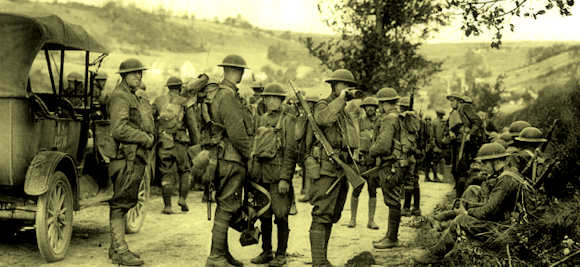 |
| U.S. Marines in the Caribbean with Springfields |
Originally presented at Warfare History Network
By Christopher Miskimon
American infantrymen carried the model 1903 Springfield rifle into battle with them for the first seven decades of the 20th century
On 17 November 1915, Major Smedley Butler and a small force of U.S. Marines approached the old French bastion of Fort Riviere in Haiti. A group of rebels known as Cacos had taken refuge there, and Butler was sent to weed them out. Part of the 100-man Marine contingent crept close to the rundown fort and surrounded it to prevent the enemy’s escape, while another group made ready to attack the fort itself. After the Americans had moved into place, Butler blew a whistle to begin the attack. The Cacos were taken by surprise. Butler and a small force rushed the fort’s wall and found a small tunnel that led inside. Two Marines, Sergeant Ross Iams and Private Sam Gross, bayonets affixed to their Model 1903 Springfield rifles, joined Butler in leading the way into Fort Riviere. Once inside the fort’s crumbling walls, they quickly found themselves under desperate attack by the Cacos, who were armed with machetes and clubs.
Iams and Gross fought off the Cacos with their Springfields and continued to use their rifles to good effect even after the fighting evolved into a wild melee of hand-to-hand combat. Together, the three Marines opened the way for the capture of the fort and the destruction of the Caco force. For their bravery, the three would be awarded the Medal of Honor. For Butler, it would be his second Medal of Honor.
 |
| WWI: First Division Soldiers Equipped with Springfields |
The Model 1903 Springfield rifle the Marines carried that day began its life as the United States took its first steps onto the world stage at the beginning of the 20th century. The United States had just completed a war with Spain, a victory that handed the Americans a set of overseas possessions including Cuba, Puerto Rico, and the Philippines. The rifle American soldiers carried in that conflict was the Krag-Jorgenson, the first bolt-action repeating rifle to become general issue to the army. The Krag had done its job, but it also had shortcomings. Its cartridge, the .30-40, lacked power and range compared to that of the German-designed Mauser rifles used by the Spanish. Krags also had to be loaded one cartridge at a time, while Mausers could be quickly loaded with five rounds connected by a stripper clip, giving Mauser shooters a higher overall rate of fire. The German rifle was fast becoming the world standard; in the event of another war, the United States could easily find its soldiers outgunned.
Research began quickly, and by 1900 the first prototype for the Krag’s replacement was being tested at the Springfield Armory in Massachusetts, then the country’s primary facility for the research and production of small arms. Several revisions ensued as part of the testing process, but by 1902 examples were being field-tested at Forts Riley and Leavenworth, Kansas. Reviews were overwhelmingly favorable, and on 19 June 1903, the weapon was officially adopted as “United States Magazine Rifle, Model of 1903, Caliber .30.” Whatever the formal nomenclature, it would forever be known as the 03 Springfield. The Armory ceased production of the Krag and began cranking out the new rifle at the initial rate of 225 per day, with more than 30,000 produced the first year alone.
Continue reading the article HERE

I've heard that the '03 Springfield when compared to the Garand would get an extra 100 yards, explaining its use as a sniper rifle. Recall both are firing the 30x06 round.
ReplyDeleteA bolt-action will always be more accurate than one that allows a variable amount of propellant gas to escape before the bullet passes its exit point at the muzzle.. -- Dick in Gig Harbor WA
ReplyDeleteWhen I was in Spraker Rifles, the Honor Guard & Drill Team for Georgetown ROTC in the early fifties, we were issued the Springfield 03. My Platoon Leader was Lt Antonin Scalia.
ReplyDelete